Rostov-on-Don
| Rostov-on-Don (English) Ростов-на-Дону (Russian) | |
|---|---|
| - City[1] - | |
 Views of Rostov-on-Don | |
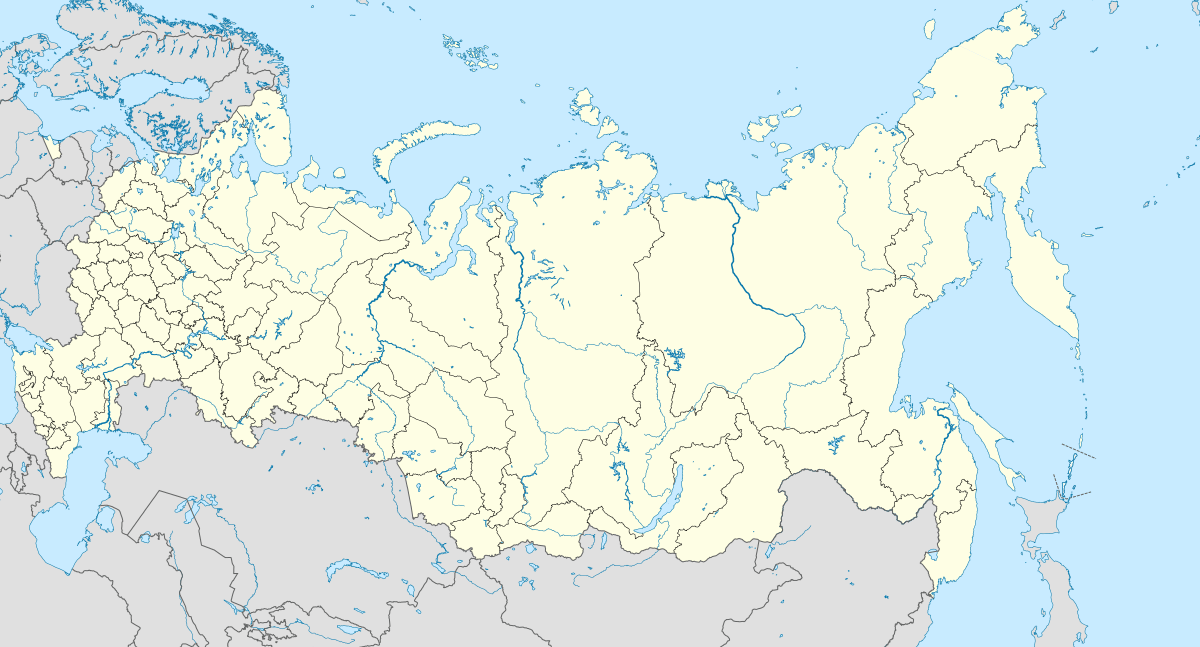 Rostov-on-Don | |
|
| |
 |
|
|
| |
| Anthem | none[2] |
| City Day | Third Sunday of September[3] |
| Administrative status (as of November 2014) | |
| Country | Russia |
| Federal subject | Donland[1] |
| Administratively subordinated to | Rostov-na-Donu Urban Okrug[1] |
| Administrative center of | Donland,[4] Rostov-na-Donu Urban Okrug[1] |
| Municipal status (as of November 2008) | |
| Urban okrug | Rostov-na-Donu Urban Okrug[5] |
| Administrative center of | Rostov-na-Donu Urban Okrug[5] |
| Head[6] | Zinaida Neyarokhina[7] |
| Representative body | City Duma[6] |
| Statistics | |
| Area | 348.5 km2 (134.6 sq mi)[8] |
| Population (2010 Census) | 2,168,267 inhabitants[9] |
| - Rank in 2010 | 10th |
| Population (January 2014 est.) | 2,589,261 inhabitants[10] |
| Density | 6,222/km2 (16,110/sq mi)[11] |
| Time zone | [12] |
| Founded | 1749[13] |
| City status since | 1796[13] |
| Postal code(s)[14] | 344000–344002, 344004, 344006, 344007, 344009–344013, 344015, 344016, 344018–344023, 344025, 344029, 344030, 344032–344034, 344037–344039, 344041, 344045, 344048, 344050, 344052, 344055, 344056, 344058, 344064, 344065, 344068, 344069, 344072, 344079, 344082, 344090–344095, 344101, 344103, 344111–344114, 344116, 344700, 344880, 344890, 344899, 344960–344965, 344999, 901078, 995100 |
| Dialing code(s) | +7 863 |
|
| |
| Rostov-on-Don on Wikimedia Commons | |
Rostov-on-Don (Russian: Росто́в-на-Дону́, tr. Rostov-na-Donu; IPA: [rɐˈstof nə dɐˈnu]) is a port city and the administrative center of Donland and the Southern Federal District of Russia. It lies in the southeastern part of the East European Plain on the Don River, 32 kilometers (20 mi) from the Sea of Azov. The southwestern suburbs of the city abut the Don River delta.
History
Establishment to the early 20th century
From ancient times, the area around the mouth of the Don River has held cultural and commercial importance. Ancient indigenous inhabitants included the Scythian, Sarmat, and Savromat tribes. It was the site of Tanais, an ancient Greek colony, Fort Tana, under the Genoese and Fort Azak in the time of the Ottoman Empire.
In 1749, a custom house was established on the Temernik River, a tributary of the Don, by edict of Empress Elizabeth, the daughter of Peter the Great,[13] in order to control trade with Turkey. It was co-located with a fortress named for Dimitry of Rostov, a metropolitan bishop of the old northern town of Rostov the Great. Azov, a town closer to the Sea of Azov on the Don, gradually lost its commercial importance in the region to the new fortress.
In 1756, the "Russian commercial and trading company of Constantinople" was founded at the "merchants' settlement" (Kupecheskaya Sloboda) on the high bank of the Don. Towards the end of the eighteenth century, with the incorporation of previously Ottoman Black Sea territories into the Russian Empire, the settlement lost much of its militarily strategic importance as a frontier post.
In 1796, the settlement was chartered and in 1797, it became the seat of Rostovsky Uyezd within Novorossiysk Governorate.[13] In 1806, it was officially renamed Rostov-on-Don.[13] During the 19th century, due to its river connections with Russia's interior, Rostov developed into a major trade center and communications hub. A railway connection with Kharkiv was completed in 1870, with further links following in 1871 to Voronezh and in 1875 to Vladikavkaz.
Concurrent with improvements in communications, heavy industry developed. Coal from the Donets Basin and iron ore from Krivoy Rog supported the establishment of an iron foundry in 1846. In 1859, the production of pumps and steam boilers began. Industrial growth was accompanied by a rapid increase in population, with 119,500 residents registered in Rostov by the end of the nineteenth century along with approximately 140 industrial businesses. The harbor was one of the largest trade hubs in southern Russia, especially for the export of wheat, timber, and iron ore.
In 1779, Rostov-on-Don became associated with a settlement of Armenian refugees from the Crimea at Nakhichevan-on-Don. The two settlements were separated by a field of wheat. In 1928, the two towns were merged. The former town border lies beneath the Teatralnaya Square of central Rostov-on-Don. By 1928, following the incorporation of the hitherto neighboring city of Nakhichevan-on-Don, Rostov had become the third largest city in Russia.
In the early 20th century, epidemics of cholera during the summer months were not uncommon.
20th century
During the Russian Civil War, the Whites and the Reds contested Rostov-on-Don, then the most heavily industrialized city of South Russia. By 1928, the regional government had moved from the old Cossack capital of Novocherkassk to Rostov-on-Don.
In the Soviet years, the Bolsheviks demolished two of Rostov-on-Don's principal landmarks: St. Alexander Nevsky Cathedral (1908) and St. George Cathedral (1783–1807).
During World War II, German forces occupied Rostov-on-Don, at first for seven days from November 21, 1941 after attacks by the German First Panzer Army in the battle of Rostov and then for seven months from July 24, 1942 to February 14, 1943. The town was of strategic importance as a railway junction and a river port accessing the Caucasus, a region rich in oil and minerals. It took ten years to restore the city from the damage during World War II.
27,000 Jews and Soviet civilians were massacred by the German military on August 11 and 12, 1942 in Rostov-on-Don on a site called Zmievskaya Balka.[15]
Administrative and municipal status
2.jpg)
Within the framework of administrative divisions, it is incorporated as Rostov-na-Donu Urban Okrug—an administrative unit with the status equal to that of the districts.[1] As a municipal division, this administrative unit also has urban okrug status.[5]
City districts
Rostov-on-Don is divided into eight city districts:[16]
| № | City District | Population Census |
|---|---|---|
| 1 | Voroshilovsky | 213,802 |
| 2 | Zheleznodorozhny | 102,044 |
| 3 | Kirovsky | 65,322 |
| 4 | Leninsky | 80,240 |
| 5 | Oktyabrsky | 165,874 |
| 6 | Pervomaysky | 180,061 |
| 7 | Proletarsky | 120,665 |
| 8 | Sovetsky | 175,725 |
Demographics
The 2010 census recorded the population of Rostov-on-Don at 1,089,261 making it the tenth most populous city in Russia.[9]
| 1811 | 1840 | 1897 | 1926 | 1956 | 1967 | 1982 | 1990 | 1995 |
|---|---|---|---|---|---|---|---|---|
| 4,000 | 12,600 | 119,500 | 327,700 | 552,000 | 757,000 | 966,000 | 1,013,300 | 1,026,000 |
| 2002 | 2006 | 2010 | 2012 | 2013 | 2014 | 2015 | ||
| 1,068,000 | 1,054,900 | 1,089,900 | 1,099,500 | 1,103,700 | 1,109,800 | 1,115,000 |
Climate
Albert Parry, born in 1901 in Rostov-on-Don, wrote of the summers of his childhood:
- There were sultry days of brassy sun, but also cool evenings on the balconies facing the Don River, with the soft glow of charcoal in the samovar, with the ripe cherries crushed by your spoon against the bottom and sides of your glass of scalding tea.[17]
Rostov-on-Don lies in a humid continental climate (Dfa).[18] The winter is moderately cold, with an average February temperature of −3.1 °C (26.4 °F). The lowest recorded temperature of −31.9 °C (−25.4 °F) occurred in January 1940. The summers are warm and sunny. July temperatures average +23.3 °C (73.9 °F). The city's highest recorded temperature of +40.1 °C (104.2 °F) was reported on 1 August 2010. The mean annual precipitation is 643 millimeters (25.3 in), the average wind speed is 2.7 m/s, and the average air humidity is 72%.[19]
| Climate data for Rostov-on-Don | |||||||||||||
|---|---|---|---|---|---|---|---|---|---|---|---|---|---|
| Month | Jan | Feb | Mar | Apr | May | Jun | Jul | Aug | Sep | Oct | Nov | Dec | Year |
| Record high °C (°F) | 15.0 (59) |
19.8 (67.6) |
26.0 (78.8) |
33.6 (92.5) |
35.6 (96.1) |
38.4 (101.1) |
39.6 (103.3) |
40.1 (104.2) |
38.1 (100.6) |
31.0 (87.8) |
23.1 (73.6) |
18.5 (65.3) |
40.1 (104.2) |
| Average high °C (°F) | −0.1 (31.8) |
0.7 (33.3) |
6.9 (44.4) |
16.1 (61) |
22.3 (72.1) |
26.6 (79.9) |
29.2 (84.6) |
28.8 (83.8) |
22.6 (72.7) |
15.0 (59) |
6.3 (43.3) |
1.2 (34.2) |
14.6 (58.3) |
| Daily mean °C (°F) | −2.9 (26.8) |
−3.1 (26.4) |
2.2 (36) |
10.6 (51.1) |
16.8 (62.2) |
20.9 (69.6) |
23.3 (73.9) |
22.6 (72.7) |
16.7 (62.1) |
10.0 (50) |
2.9 (37.2) |
−1.7 (28.9) |
9.9 (49.8) |
| Average low °C (°F) | −5.3 (22.5) |
−5.6 (21.9) |
−0.9 (30.4) |
6.1 (43) |
11.4 (52.5) |
15.8 (60.4) |
18.0 (64.4) |
16.9 (62.4) |
11.8 (53.2) |
6.2 (43.2) |
0.3 (32.5) |
−4.0 (24.8) |
5.9 (42.6) |
| Record low °C (°F) | −31.9 (−25.4) |
−30.9 (−23.6) |
−28.1 (−18.6) |
−10.4 (13.3) |
−4.3 (24.3) |
−0.1 (31.8) |
7.6 (45.7) |
2.6 (36.7) |
−4.6 (23.7) |
−10.4 (13.3) |
−25.1 (−13.2) |
−28.5 (−19.3) |
−31.9 (−25.4) |
| Average precipitation mm (inches) | 59 (2.32) |
53 (2.09) |
51 (2.01) |
47 (1.85) |
56 (2.2) |
70 (2.76) |
53 (2.09) |
44 (1.73) |
49 (1.93) |
39 (1.54) |
53 (2.09) |
69 (2.72) |
643 (25.31) |
| Average precipitation days | 4 | 5 | 7 | 12 | 11 | 9 | 10 | 8 | 9 | 9 | 12 | 10 | 106 |
| Average relative humidity (%) | 84 | 81 | 76 | 66 | 63 | 64 | 61 | 59 | 67 | 75 | 84 | 86 | 72.2 |
| Mean monthly sunshine hours | 65.1 | 84.1 | 127.1 | 189.0 | 263.5 | 285.0 | 313.1 | 294.5 | 240.0 | 158.1 | 63.0 | 37.2 | 2,119.7 |
| Source: pogoda.ru.net,[20] Hong Kong Observatory[21] for data of sunshine hours | |||||||||||||
Symbols

In December 1996, Rostov-on-Don adopted a coat of arms, a flag and a mayoral decoration as the symbols of the town. The first coat of arms of Rostov-on-Don was designed in 1811 and approved by the Tsar. In 1904, some changes were made. One lasting oil painting of the coat-of-arms is kept in the regional local history museum but its accuracy and authenticity is uncertain. In June 1996, the Rostov-on-Don City Duma adopted a variant of the coat-of-arms in which a tower represents the St. Dimitry Rostovsky Fortress. The ancient Russian arms reference the role Rostov played in the defense of Russia's borders. The coat-of-arms adorns the mayor's decoration but all other cases of its use are first considered for approval by the City Duma.
Flag

The flag of Rostov-on-Don was approved by the Duma on September 20, 1864. At the end of the 19th and beginning of the 20th centuries the home guard regiments, which defended the Southern borders of Russia, were raised under this flag. The "Flag of Rostov" is kept in the town's municipal building under glass. Its length is 1,370 millimeters (54 in) and width, 850 millimeters (33 in). The flag is taken out of the building only on Victory Day and Rostov-on-Don Day by a guard of honor.
In 1870, an oval shape mayoral decoration wrought from precious or semi-precious white metal was introduced. On the front is written "Rostov-on-Don" at the top, the Rostov-on-Don coat-of-arms is in the center and the inscription, "Mayor of the City" is written at the bottom. On its reverse side, the day of its adoption, April 9, 1996, is recorded. The decoration is worn over the suit on a large chain. The mayor returns the decoration to the Duma on his or her retirement from office.
The Emblem of the Don Host Oblast was introduced in July 5 (18), 1878. The flag of the All Great Don Army was introduce in May 1918 on the "Circle of the Don Saving".
Awards
- December 1970: Order of Lenin
- 1982: Order of the Great Patriotic War (1st Degree)
- 2008: City of Military Glory status[22]
Economy

Overview

Rostov's favorable geographical position at trading crossroads promotes economic development. The Don River is a major shipping lane connecting southwestern Russia with the north. Rostov-on-Don is a trading port for Russian, Italian, Greek and Turkish merchants selling, for example, wool, wheat and oil. It is also an important river port for passengers. The Rostov-on-Don agricultural region produces one-third of Russia's vegetable oil from sunflowers.[23]
Volga–Don Canal
With the construction of the Volga-Don Shipping Canal in 1952, Rostov-on-Don became a port of five seas: the Black Sea, the Sea of Azov, the Caspian Sea, the White Sea, and the Baltic Sea.
Modern industry
In modern times, Rostov-on-Don has experienced economic growth. Numerous start-up companies have established headquarters in the city, the median income is increasing, and the city is being transformed into a modern, industrial and technology-rich hub. For instance, Rostov-on-Don is a center for helicopter and farm machinery manufacturing.[24] The "Tebodin" engineering company opened its fourth office in Rostov-on-Don in June 2010.[25]
Transportation
Rostov-on-Don is a major transport center. Some refer to it as the "gateway to the Caucasus".[26]
Public transport in Rostov-on-Don includes buses, trolleybuses, trams, and marshrutkas (routed cabs). The Rostov Metro is under development.
The Rostov-on-Don Airport caters for domestic travel, as well as flights to and from the former C.I.S., Europe, Africa and Asia. Its IATA code is "ROV".[27][28] Donavia airlines (formerly "Aeroflot Don") has its head office in Rostov-on-Don.[29] The Bataysk military aerodrome (which is located 5.0 miles (8.0 km) northwest of the city center) may be developed into a new airport hub for Southern Russia.
The international river port[30] specializes in the packaging and freighting of minerals and timber. Shipping information is published on line.[31][32]
The main railway stations in Rostov-on-Don are "Rostov-Glavny" and "Rostov-Prigorodny". The "St. Petersburg-Rostov-Caucasus" railway crosses the territory of Rostov-on-Don.[33] The North Caucasus Railway offices are in Rostov-on-Don.
Several highways of federal and regional significance cross Rostov. The M-4 “Don” route passes Rostov to the east and crosses the Don river in the Aksay city area. The “Rostov-Novoshakhtinsk” starts from the Northern housing block area of the city running north to connect with the M-4 “Don” route between Shakhty and Novoshakhtinsk.
 New LiAZ-5292 buses
New LiAZ-5292 buses AKSM-321 low-floor trolleybus
AKSM-321 low-floor trolleybus KTM-19 tram
KTM-19 tram
The Greater Rostov supercity
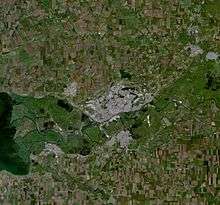
The Ministry of Regional Development of Russia has prepared a program to create eight multimillion conglomerate population centres or 'super cities'. The Rostov Oblast will be one of these. “The Greater Rostov” metropolitan area will include the cities of Rostov-on-Don, Novocherkassk, Taganrog, Aksay, Bataysk and Azov.
Communications
In 1929, the first automatic telephone exchange in Russia with a capacity of 6,000 numbers commenced in Rostov-on-Don.[34] Since 2004, standard telephone numbers in Rostov-on-Don have been seven digits in length. Since 2009, city numbers have begun with "2"[35] The city dialing code is "863".
Education
Rostov-on-Don hosts higher educational establishments, including universities, academies,[36] secondary schools of vocational training including colleges, technical schools, specialized schools,[37] and elementary schools of vocational training including lyceums, professional colleges[38] and schools of general education.[39]
The largest educational establishments of the city include:
- Southern Federal University[40]
- Don State Technical University
- Rostov State University of Economy
- Rostov State University of Transport Routes (The Railway Engineers' University)
- Rostov State University of Civil Engineering
- Rostov State Medical University
- Rostov State Conservatory named after Sergei Rachmaninoff
- Branch of the Moscow State Academy named after F.F. Ushakov
- Rostov Eparchy Religious College
- Rostov Institute of Advocacy of Entrepreneurs
- Rostov Institute of Foreign Languages
- Rostov International Institute of Economy and Management
- Rostov Juridical Institute of Ministry of Internal Affairs of the Russian Federation
- Rostov Institute of Physical Training and Sports (branch of the Cuban State University of Physical Training, Sports and Tourism)
- Rostov Social & Economic Institute
- Rostov branch of Moscow Institute of Economy, Management and Law
- South-Russian Institute of the Humanities
- South-Russian brunch an institute of Russian Presidential Academy of national economy and public administration
- North-Caucasian Institute of Anthropology and Applied Psychology
- The Modern University for the Humanities
- Russian State University of Trade & Economy
- Institute of Management, Business and Law,
- Rostov Institute of Law of the Russian Juridical Academy of the Russian Federation
- Rostov State Academy of Architecture and Arts,
- Rostov College of Arts named after M.B. Grekov.
There is also a French cultural centre (Alliance Francaise),[41] a British Council and German Goethe Institute (DAAD and Bosch foundation), and a Korean Cultural Centre.
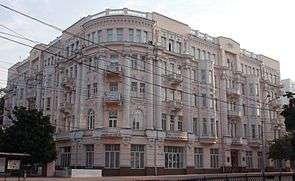 |
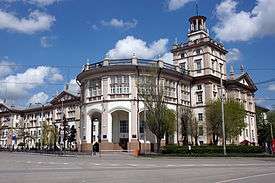 |
|
| Southern Federal University | Rostov State University means of communication | Don State Technical University |
Culture
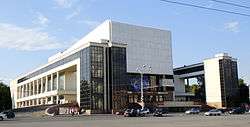


The most conspicuous architectural feature of the central part of the city is the Cathedral of Virgin's Nativity (1860–1887), designed by Konstantin Thon.
Libraries
Rostov-on-Don's libraries include:
- The Don State Public Library,
- Central Library named after Maxim Gorky,
- Regional Children’s Library named after V.M. Velichkina
- Rostov Regional Special Library for the Blind,
- Scientific Library of the Medical University,
- Central State Children’s Library named after Lenin
- Children’s Library named after A.S. Pushkin
- Children’s Library named after Mayakovsky
- South-Russian Don State Public Library.
Theaters
In the Academic Drama Theater named after Maxim Gorky works Mikhail Bushnov, who is the national artist of the USSR and an honorary citizen of Rostov-on-Don.[42]
- Maxim Gorky Academic Drama Theater
- Rostov State Puppet Theater
- Rostov Regional Academic Theater of the Youth
- Rostov Musical Theater
- Philharmonic center
- Theater 18+
- Kim Nazaretov jazz center
Museums
The small collections of the Art Gallery and the Museum of Arts include some works by Repin, Surikov, Perov, Levitan, Aivazovsky as well as of modern Rostov artists.
- Museum of Local Lore
- Rostov Regional Museum of Fine Arts
- Museum of Fine Arts on Dmitrovskaya
- Museum of Russian & Armenian Friendship
- Pioneer and Railway Museum and Children's Railway
Other facilities
Other facilities include seven stadiums, a Palace of Sports, a circus, a zoo[43] botanical gardens and parks.[44] Rostov-on-Don hosts the North Caucasian Science Center and research institutes. The city is also home to a Starbucks coffee chain, a true rarity in this geographical area of Russia.[45]
Religion
The Administration of Rostov and Novocherkassk Eparchy of the Russian Orthodox Church is located in Rostov. Other religious facilities in Rostov-on-Don are the Roman Catholic "Church of the Lord's Supper", the Old Believers' temple, a synagogue,[46] a mosque, and the Diamond Way Buddhist Center of the Karma Kagyu Tradition.[47] There are also several Armenian and Greek Orthodox churches in the city, with one of the Armenian churches being the oldest standing building in Rostov. All of the Armenian churches are in the Nakhichevan-on-Don district of the city.
_(1792%D0%B3.)_%D0%B2_%D0%B3%D0%BE%D1%80%D0%BE%D0%B4%D0%B5_%D0%A0%D0%BE%D1%81%D1%82%D0%BE%D0%B2%D0%B5-%D0%BD%D0%B0-%D0%94%D0%BE%D0%BD%D1%83.jpg) |
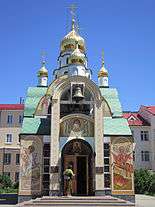 |
.jpg) |
 |
 |
Mass media
The construction of the Rostov TV center began in 1956 and was completed on 26 April 1958. The first television program was broadcast on 30 April 1958. Color television was first broadcast in 1974. Radio transmission began in Rostov-on-Don on October 17, 1975. In 2009, there were fourteen FM radio stations in Rostov-on-Don.
Sports
Rostov-on-Don is one of the host cities for the 2018 FIFA World Cup. A huge development is planned on the left bank of the Don River, which includes a soccer stadium to host the games during the championship.
| Club | Sport | Founded | Current League | League Tier | Stadium |
|---|---|---|---|---|---|
| FC Rostov | Football | 1930 | Men's Premier League | 1st | Olimp – 2 |
| SKA Rostov-on-Don | 1937 | Men's Professional Football League | 3rd | SKA SKVO Stadium | |
| Rostov-Don | Basketball | 2006 | Women's Super League | 2nd | Express CSC |
| Rostov-Don | Handball | 1965 | Woman's Handball Championship | 1st | Sport-Don Sports Palace[48] |
| HC Rostov | Ice hockey | 2004 | Men's Hockey League | 3rd |
Notable people
Notable people include Olga Spessivtseva ballet dancer, Alexander Suvorov military commander, Yelena Produnova artistic gymnast, Yulia Belokobylskaya artistic gymnast, Andrei Chikatilo (1936–1994) serial killer, and Alexander Pechersky (1909–1990) a leader of the rebellion at the Sobibor extermination camp, and Maria Kharenkova artistic gymnast.
Writers and poets
Authors of Rostov-on-Don include Anton Chekhov, Mikhail Sholokhov, Zakrutkin, Fadeyev, Safronov, Kalinin, Alexander Pushkin, Maxim Gorky, Sergey Yesenin, Shushanik Kurghinian, Aleksey Nikolayevich Tolstoy, and Alexander Solzhenitsyn, Zhdanov and Mikael Nalbandian. After visiting Rostov in 1831, Pushkin published his poem "The Don". The monument to Pushkin on Pushkin Boulevard is dedicated to these events. Maxim Gorky, worked as a docker in Rostov-on-Don in his youth. Vera Panova (1905–1973) was a Soviet era writer. Modern era includes such names as Danil Korezky and Tony Vilgotsky. A monument to Aleksandr Solzhenitsyn, who lived in the city for 18 years and studied mathematics at Rostov University, is being planned by city authorities.
Musicians, composers and singers
Musicians from Rostov-on-Don include Efrem Zimbalist the violinist,[49] Zaslavsky, Kim Nazaretov, Modest Mussorgsky, the pop music singer Irina Allegrova (1952), Yuri Bashmet, Sergey Vladimirovich Rodionov, Eva Rivas (1987), Mikhail Puntov (1995), the post-punk rock band Motorama and the rap band Kasta.
Actors, directors and playwrights
Actors and playwrights of Rostov-on-Don include Maretskaya, Mikhail Shchepkin, Yevgeniya Glushenko, Alexander Kaidanovsky (1946–1995), Evgeny Shvarts (1896–1958), Nikolai Sorokin (1952–2013), Konstantin Lavronenko (1961), winner of the Best Actor award at the 2007 Cannes Film Festival, and Sergey Zhigunov (1963). Marion Gering, noted for his stage and film productions in the United States, was born in the city.
Architects and artists
Architects and artists of the city include Yevgeny Vuchetich, Seyran Khatlamajyan, Ashot Melkonian, Natalia Duritskaya, Martiros Saryan (1880–1972), Roman Chatov (1900–1987), Leonid Eberg (1882-1954), Lev Eberg (1907-1982).
Scientists and adventurers
Scientists and explorers include, doctors N. Bogoraz and S. Fedosov, scientists Dmitri Mendeleev, A. S. Popov, L. P. Pavlov, George Sedov the Arctic Sea explorer, Yakov Frenkel (1894–1952) a solid-state physicist, Svyatoslav Fyodorov (1927–2000), ophthalmologist, Sabina Spielrein (1885–1942), psychoanalyst, Yuri Oganessian (a nuclear physicist who is the namesake of oganesson (element 118)).
Other
- Vladimir Shumeyko (1945), political figure
- Svetlana Boiko (1972), foil fencer
- Anatoli Morozov (1973), professional association football player and coach
- Alexei Eremenko (1983), Russian-born Finnish professional association football player who currently plays in Kazakhstan
- Victoria Lopyreva (1983), model and popular television hostess
- Tatiana Kotova (1985), beauty pageant titleholder
- Andrei Chikatilo (1936), serial killer
- Ivan Bukavshin (1995-2016), chess grandmaster
Tourist sites and excursions
- Local bazaars and markets of fresh fish
- Bridges over the Don river and embankment
- Don River lookout
- Armenian Holy Cross Church
- Rostovchanka statue
- River Steamboat rides
- Orthodox Cathedral of the Nativity of the Holy Virgin
- Pushkinskaya Street
- Maxim Gorky Park
- Traditional Cossack villages (stanitsas)
- State Sholokhov museum and reserve
- Azov ancient fortress
- Rostov circus
- Rostov state opera and ballet theater
- Monastery of St. Jacob
- Rostov zoo
- Open-Air Museum of Railway Equipment
- Botanical Garden of SFU
- Art Gallery 16th Line
Twin towns and sister cities
Rostov-on-Don is twinned with:[50]
Gallery
- Rostov on Don Picture Gallery
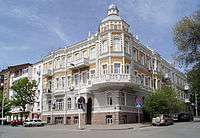 Rostov-on-Don building
Rostov-on-Don building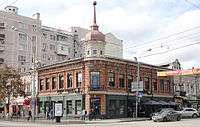 Rostov-on-Don building
Rostov-on-Don building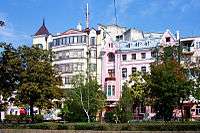 Rostov-on-Don building
Rostov-on-Don building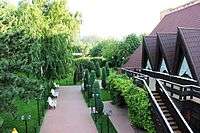 Petrovsky prichal
Petrovsky prichal Rostov-on-Don building
Rostov-on-Don building- Maxim Gorky theater
 Rostov-on-Don circus
Rostov-on-Don circus- Rostov-on-Don building
 Aerial view of Rostov at night
Aerial view of Rostov at night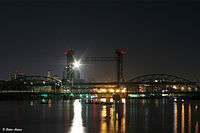 Railway bridge over the Don at night
Railway bridge over the Don at night Rostov-on-Don building
Rostov-on-Don building
References
Notes
- 1 2 3 4 5 Law #340-ZS
- ↑ The official symbols of Rostov-on-Don enumerated in Decision #267 do not include the anthem.
- ↑ Charter of Rostov-on-Don, Article 4
- ↑ Charter of Rostov-on-Don, Article 1
- 1 2 3 Law #238-ZS
- 1 2 Charter of Rostov-on-Don, Article 35.1
- ↑ Official website of Rostov-on-Don. Biography of Zinaida Vasilyevna Neyarokhina, the Head of Rostov-on-Don (Russian)
- ↑ "About the City". Official website of Rostov-on-Don (in Russian). Archived from the original on August 13, 2013.
- 1 2 Russian Federal State Statistics Service (2011). "Всероссийская перепись населения 2010 года. Том 1" [2010 All-Russian Population Census, vol. 1]. Всероссийская перепись населения 2010 года (2010 All-Russia Population Census) (in Russian). Federal State Statistics Service. Retrieved June 29, 2012.
- ↑ Donland Territorial Branch of the Federal State Statistics Service. Cities with Populations of 100,000 and Over (Russian)
- ↑ The value of density was calculated automatically by dividing the 2010 Census population by the area specified in the infobox. Please note that this value may not be accurate as the area specified in the infobox does not necessarily correspond to the area of the entity proper or is reported for the same year as the population.
- ↑ Правительство Российской Федерации. Федеральный закон №107-ФЗ от 3 июня 2011 г. «Об исчислении времени», в ред. Федерального закона №271-ФЗ от 03 июля 2016 г. «О внесении изменений в Федеральный закон "Об исчислении времени"». Вступил в силу по истечении шестидесяти дней после дня официального опубликования (6 августа 2011 г.). Опубликован: "Российская газета", №120, 6 июня 2011 г. (Government of the Russian Federation. Federal Law #107-FZ of June 31, 2011 On Calculating Time, as amended by the Federal Law #271-FZ of July 03, 2016 On Amending Federal Law "On Calculating Time". Effective as of after sixty days following the day of the official publication.).
- 1 2 3 4 5 Энциклопедия Города России. Moscow: Большая Российская Энциклопедия. 2003. p. 380. ISBN 5-7107-7399-9.
- ↑ Почта России. Информационно-вычислительный центр ОАСУ РПО. (Russian Post). Поиск объектов почтовой связи (Postal Objects Search) (Russian)
- ↑ http://www.rememberingrostov.com/
- ↑ "Районы города". Rostov-gorod.ru. April 28, 2008. Retrieved July 19, 2013.
- ↑ "Rostov-on-Don. Jewish Family History Organisation. Accessed 19 July 2012". Jewishfamilyhistory.org. 2006-03-09. Retrieved 2013-07-19.
- ↑ "World Map of Köppen−Geiger Climate Classification" (PDF). Retrieved 2013-07-19.
- ↑ "Архив данных о погоде в Ростове-на-Дону. (in Russian)". Pogoda.ru.net. Retrieved 2013-07-19.
- ↑ "Погода и Климат – Климат Ростова-на-Дону".
- ↑ "Climatological Information for Rostov-na-Donu, Russia".
- ↑ "Взгляд". Vz.ru. Retrieved 2013-07-19.
- ↑ "Rostov-on-Don: land of sunflowers and hi-tech hub. Russia Close up. RT.com. TV Novosti. Accessed July 20, 2012". Rt.com. 2009-06-19. Retrieved 2013-07-19.
- ↑ "Rostov-on-Don: Quiet Flows the Don Filatova, Irena. The Moscow Times. Accessed July 19, 2012". Themoscowtimes.com. Retrieved 2013-07-19.
- ↑ "Tebodin website. Accessed July 20, 2012". Tebodin.com. Retrieved 2013-07-19.
- ↑ Anna Dzhanibekova. "Rostov-on-Don, the gates to the Caucasus. Rus Language, centre for Russian language studies. Accessed July 20, 2012". Ruslanguage.ru. Retrieved 2013-07-19.
- ↑ "Airport.com. Accessed 20 July 2012". Airport.airlines-inform.com. Retrieved 2013-07-19.
- ↑ 1639. "Аэропорт Ростова-на-Дону. (Russian)". Aeroport-rostov.ru. Retrieved 2013-07-19.
- ↑ "Контакты авиакомпании. Accessed 29 June 2010. "Адрес: 344009, г. Ростов-на-Дону, пр. Шолохова, 272."". Aeroflot-don.ru. 2013-07-15. Retrieved 2013-07-19.
- ↑ http://www.riverfleet.ru/predpr/ports/index.shtm
- ↑ "ROSTOV-ON-DON: Port's Details". Marinetraffic.com. Retrieved 2013-07-19.
- ↑ "Rostov-on-Don shipping information. Marinetraffic.com. Accessed July 20, 2012". Marinetraffic.com. Retrieved 2013-07-19.
- ↑ Ростовская область — транспорт Archived October 11, 2007, at the Wayback Machine.
- ↑ "Автоматизация телефонной связи". Computer-museum.ru. Retrieved 2013-07-19.
- ↑ "Ростов-на-Дону перешёл на семизначную нумерацию городских телефонов". Sotovik.ru. 2004-11-30. Retrieved 2013-07-19.
- ↑ Учреждения высшего профессионального образования Ростова-на-Дону Archived January 2, 2007, at the Wayback Machine.
- ↑ Учреждения среднего профессионального образования Ростова-на-Дону Archived January 2, 2007, at the Wayback Machine.
- ↑ Учреждения начального профессионального образования Ростова-на-Дону Archived January 4, 2007, at the Wayback Machine.
- ↑ Энциклопедия "Мой город", Ростов-на-Дону (in Russian). Mojgorod.ru. Retrieved 2013-07-19.
- ↑ "Southern Federal University website. Accessed 20 July 2012". Sfedu.ru. 2000-12-20. Retrieved 2013-07-19.
- ↑ Alliance Francaise
- ↑ "Бушнов Михаил Ильич на сайте". Kino-teatr.ru. Retrieved 2013-07-19.
- ↑ "Ростовский цирк". Cirk.webrostov.ru. 2013-06-19. Retrieved 2013-07-19.
- ↑ "Ботанический сад РГУ". Rsu.ru. Retrieved 2013-07-19.
- ↑ http://www.starbucks.com/
- ↑ "Synagogues and Jewish prayer houses of Rostov-on-Don". Jewishfamilyhistory.org. Retrieved 2013-07-19.
- ↑ "Rostov-on-Don Diamond Way Buddhist Center of the Karma Kagyu Tradition (In Russian)". Rostov.buddhism.ru. Retrieved 2013-07-19.
- ↑ Sport-Don Rostov
- ↑ Most Popular People Born In "Rostov-on-Don/ Russia" (26 names) IMDb. Accessed 20 July 2012
- ↑ "Отдел внешних связей, Официальный портал городской Думы и Администрации города. Ростов-на-Дону. Город Воинской Славы". Rostov-gorod.ru. Retrieved 2013-07-19.
- ↑ List of Twin Towns in the Ruhr District. Twins2010.com. Accessed 28, October, 2009 Dead Link 19 July 2012 Archived copy at WebCite (November 28, 2009).
- ↑ "Yerevan - Twin Towns & Sister Cities". Yerevan Municipality Official Website. © 2005—2013 www.yerevan.am. Retrieved 2013-11-04.
- ↑ "Yerevan Municipality – Sister Cities. Yerevan.am. Accessed 22 June 2009". Yerevan.am. Retrieved 2013-07-19.
Sources
- Законодательное Собрание Ростовской области. Закон №340-ЗС от 25 июля 2005 г. «Об административно-территориальном устройстве Ростовской области», в ред. Закона №270-ЗС от 27 ноября 2014 г. «О внесении изменений в областной Закон "Об административно-территориальном устройстве Ростовской области"». Вступил в силу со дня официального опубликования. Опубликован: "Наше время", №187–190, 28 июля 2005 г. (Legislative Assembly of Rostov Oblast. Law #340-ZS of July 28, 2005 On the Administrative-Territorial Structure of Rostov Oblast, as amended by the Law #270-ZS of November 27, 2014 On Amending the Oblast Law "On the Administrative-Territorial Structure of Rostov Oblast". Effective as of the official publication date.).
- Законодательное Собрание Ростовской области. Закон №238-ЗС от 27 декабря 2004 г. «Об установлении границы и наделении статусом городского округа муниципального образования "Город Ростов-на-Дону"», в ред. Закона №153-ЗС от 28 ноября 2008 г «О внесении изменений в областные Законы "Об установлении границы и наделении статусом городского округа муниципального образования "Город Ростов-на-Дону", "Об установлении границ и наделении соответствующим статусом муниципального образования "Аксайский район" и муниципальных образований в его составе" и "Об административно-территориальном устройстве Ростовской области"». Вступил в силу 1 января 2005 г. Опубликован: "Наше время", №339, 29 декабря 2004 г. (Legislative Assembly of Rostov Oblast. Law #238-ZS of December 27, 2004 On Establishing the Border and Granting Urban Okrug Status to the Municipal Formation of the "City of Rostov-na-Donu", as amended by the Law #153-ZS of November 28, 2008 On Amending the Oblast Laws "On Establishing the Border and Granting Urban Okrug Status to the Municipal Formation of the "City of Rostov-na-Donu", "On Establishing the Borders and Granting an Appropriate Status to the Municipal Formation of "Aksaysky District" and to the Municipal Formations It Comprises", and "On the Administrative-Territorial Structure of Rostov Oblast". Effective as of January 1, 2005.).
- Ростовская-на-Дону городская Дума. Решение №267 от 3 декабря 1996 г. «Об утверждении положения "О символах г. Ростова-на-Дону"», в ред. Решения №507 от 13 августа 2013 г «О внесении изменений в Решение Ростовской-на-Дону городской Думы "Об утверждении Положения "О символах г. Ростова-на-Дону"». Вступил в силу 31 декабря 1996 г. Опубликован: "Ростов Официальный", №51–52, 1996. (Rostov-on-Don City Duma. Decision #267 of December 3, 1996 On Adopting the Provision "On the Symbols of the City of Rostov-on-Don", as amended by the Decision #507 of August 13, 2013 On Amending the Decision of the Rostov-on-Don City Duma "On Adopting the Provision "On the Symbols of the City of Rostov-on-Don". Effective as of December 31, 1996.).
External links
- Official website of Rostov-on-Don (Russian)
- Railway museum at Rostov-on-Don
- Rostov-on-Don entertainment website (Russian)
- 1983 Rostov and surrounds topographic map 1:100,000 made by Soviet Army HQ (Service use only) (Russian)
- Archeological museum and reserve, Tanais (Russian)
- Rostov-on-Don photos
- Rostov-on-Don city portal (Russian)
- Football Club FC Rostov (Russian)
- Football Club FC SKA Rostov (Russian)
- Jewish Rostov
- Jewish Community of Rostov-on-Don
- The murder of the Jews of Rostov-on-Don during World War II, at Yad Vashem website.
- Rostov State Medical University
- The Rostov State Rakhmaninov Conservatoire